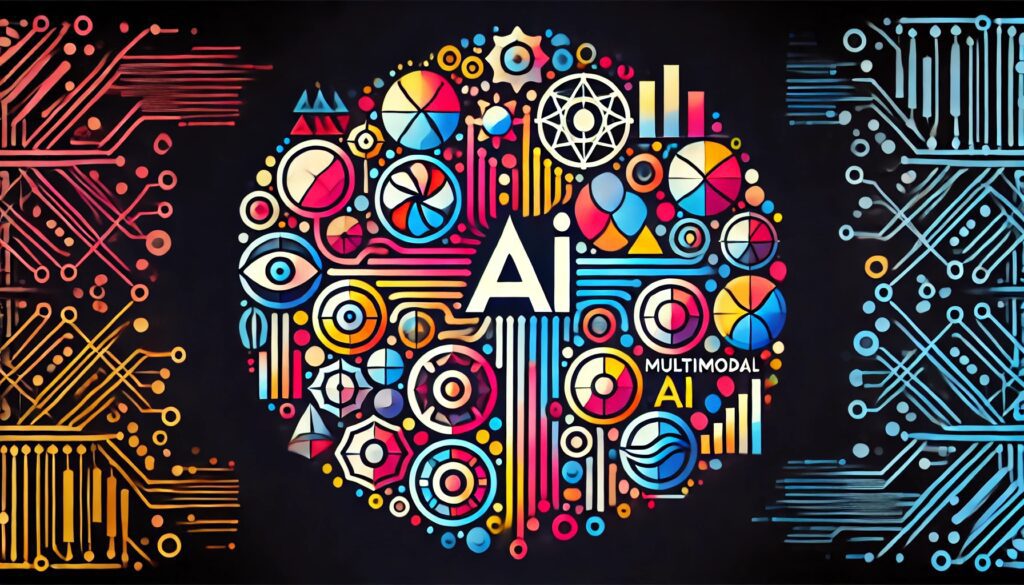
Multimodal AI is not just a buzzword—it’s a transformative technology that’s reshaping how artificial intelligence systems process and interact with the world. By integrating different types of data, multimodal AI is making it possible for machines to understand and generate complex outputs that are more aligned with human cognition. Let’s explore the deeper intricacies of this field, its profound applications, and the challenges that lie ahead.
The Core of Multimodal AI: Unifying Diverse Data Streams
At the foundation of multimodal AI is the concept of combining and processing multiple data streams simultaneously. These streams can include textual information, images, audio, video, and even haptic feedback. The goal is to create AI systems that don’t just excel in one domain but can seamlessly integrate information from various modalities to make better, more informed decisions.
Why Multimodality Matters
Human perception is inherently multimodal. When we understand our environment, we don’t rely solely on what we see or hear—we integrate information from all our senses. Multimodal AI aims to replicate this capability in machines, making them better equipped to handle real-world tasks where context and complexity are key.
Advanced Examples of Multimodal AI in Action
GPT-4 by OpenAI: Beyond Text
GPT-4 is a prime example of how multimodal AI is evolving. While earlier versions of GPT focused primarily on text, GPT-4 integrates both text and image inputs. This allows it to perform tasks like analyzing a picture and generating a detailed description, or even answering questions about the image based on textual context. By combining these two modes, GPT-4 can deliver more comprehensive and accurate responses.
DALL-E and the Fusion of Art and Language
DALL-E takes the concept of multimodal AI further by generating images from textual descriptions. This model demonstrates the potential of AI to not just interpret but also create content across different modalities. By understanding the nuances of language and translating them into visual art, DALL-E opens up new possibilities in design, advertising, and even entertainment, where creative synergy between text and imagery is crucial.
CLIP: Bridging the Gap Between Vision and Language
CLIP is another revolutionary model from OpenAI that merges visual and textual data. Unlike traditional models that focus on a single modality, CLIP can perform tasks like image classification, object detection, and image captioning by understanding the relationship between text and images. This ability makes CLIP incredibly versatile, capable of improving content moderation, enhancing search engines, and even assisting in creative workflows where visual and textual elements must align perfectly.
Complex Applications and Industry Impact
Revolutionizing Healthcare with Multimodal AI
In the healthcare industry, the integration of multimodal AI is proving to be a game-changer. For example, consider the diagnosis of complex diseases. By combining textual data from patient histories, visual data from medical imaging, and audio data from patient interviews, multimodal AI systems can provide more accurate diagnoses and personalized treatment plans. These systems can also help doctors by identifying patterns that might be missed when considering a single data type in isolation.

Example: In cancer treatment, multimodal AI can analyze radiology scans, biopsy results, and patient records to suggest the most effective treatment plans, improving patient outcomes and reducing the time required for diagnosis.
Autonomous Vehicles: Integrating Multiple Sensory Inputs
For autonomous vehicles, multimodal AI is essential. These vehicles must process a continuous stream of data from cameras, microphones, LiDAR sensors, and GPS systems to navigate safely. By integrating these different modalities, the AI can understand its surroundings more comprehensively—detecting obstacles, recognizing traffic signs, and even interpreting spoken commands from passengers.
Example: Tesla’s self-driving technology uses a combination of visual and spatial data to navigate complex driving environments. By integrating data from multiple sensors, the system can make real-time decisions that enhance safety and improve the driving experience.
Creative Industries: Multimodal Tools for the Next Generation of Creators
In the creative sectors, multimodal AI is unlocking new possibilities. Tools that combine text, images, and even sound can help artists and content creators generate rich, multimedia experiences. For instance, AI can now generate a music track that matches the mood of a script or create a video sequence based on a textual storyboard.
Example: Imagine a filmmaker who uses multimodal AI to input a script and receive a visual storyboard, complete with suggested camera angles and lighting setups. This integration saves time and enhances creativity by offering new perspectives and ideas.
The Challenges: Navigating the Complexity of Multimodal AI
Data Alignment and Synchronization
One of the primary challenges in multimodal AI is data alignment. Different data types often operate on different scales and timelines, making it difficult to synchronize them accurately. For instance, aligning the audio track of a video with its visual content requires precise timing, as even a slight misalignment can lead to incorrect interpretations.
Model Complexity and Interpretability
As AI models become more complex, integrating multiple modalities without sacrificing performance becomes a major challenge. Multimodal models are often larger and more computationally intensive than their single-modal counterparts. This complexity can also make them harder to interpret, leading to potential issues with transparency and trust.
Example: In healthcare, a multimodal AI system that integrates text and image data for diagnosis might be highly effective, but if the model’s decision-making process isn’t transparent, it could lead to challenges in regulatory approval and clinician adoption.
Computational Requirements and Scalability
The computational demands of multimodal AI are significant. Training models that can process and integrate different types of data requires immense computational resources. This limitation can restrict the accessibility of multimodal AI technologies, especially for smaller companies or applications with limited budgets.
Example: Training a multimodal AI model that integrates high-resolution video, audio, and text might require access to large-scale data centers with specialized hardware, such as GPUs or TPUs. For many organizations, these resources are either cost-prohibitive or unavailable, limiting the potential applications of multimodal AI.
The Future of Multimodal AI: Towards Truly General Intelligence
Multimodal AI is a critical step toward the development of general AI—systems that can understand, learn, and adapt across a wide range of tasks and environments, much like a human. By integrating multiple data modalities, these AI systems are moving closer to achieving this vision.
Enhanced Human-Computer Interaction
As multimodal AI continues to evolve, we can expect significant improvements in human-computer interaction. Future AI systems could understand and respond to users in a more natural and intuitive way, integrating speech, gestures, and facial expressions to create seamless interactions.
Example: Imagine a personal assistant that can understand your spoken commands, recognize your facial expressions, and even respond to your emotional state by adjusting its tone or offering relevant suggestions.
Expanding the Horizons of AI Applications
The integration of multimodal AI into various industries will continue to expand the possibilities for AI applications. From autonomous systems that navigate the real world to creative tools that generate multimedia content, the potential uses for multimodal AI are virtually limitless.
Example: In education, multimodal AI could create personalized learning experiences that adapt to each student’s needs, integrating visual content, text, and interactive elements to provide a richer and more engaging educational experience.
Building Trust and Transparency
As multimodal AI becomes more pervasive, ensuring that these systems are transparent and trustworthy will be crucial. Efforts to improve the interpretability of multimodal models and ensure that they operate fairly and ethically will be essential in gaining public trust and ensuring widespread adoption.
Example: Regulatory frameworks might require that multimodal AI systems used in critical sectors, like healthcare or transportation, include mechanisms for explainability and auditing, ensuring that their decisions can be understood and challenged if necessary.
Multimodal AI is at the forefront of the next wave of artificial intelligence, pushing the boundaries of what machines can understand and create. By integrating multiple data types, these systems are becoming more capable, versatile, and aligned with human intelligence. As we continue to explore and develop multimodal AI, the future holds incredible promise for intelligent systems that are more powerful, intuitive, and integrated than ever before.
FAQs
Here are the FAQs formatted with the questions in H4:
What is multimodal AI?
Multimodal AI refers to systems that can process and integrate multiple forms of data, such as text, images, and audio, to perform complex tasks.
Why is multimodal AI important?
Multimodal AI enhances the ability of intelligent systems to understand and interact with the world more naturally, making them more adaptable and efficient.
How does multimodal AI work?
Multimodal AI works by combining various machine learning models specialized in different data types, creating a more comprehensive understanding of information.
What are the applications of multimodal AI?
Applications range from advanced virtual assistants and smart healthcare diagnostics to sophisticated surveillance systems and immersive entertainment experiences.
What is the future of multimodal AI?
The future of multimodal AI lies in its potential to revolutionize various industries by making systems more intuitive, intelligent, and capable of complex decision-making.
What distinguishes multimodal AI from traditional AI?
Traditional AI typically processes a single type of data, like text or images. Multimodal AI, on the other hand, integrates and analyzes multiple data types simultaneously, leading to richer and more nuanced outputs.
What challenges does multimodal AI face?
Challenges include the complexity of integrating diverse data sources, ensuring the models remain interpretable, and managing the computational resources required for processing multiple modalities.
How does multimodal AI improve user interactions?
By combining different data types, such as voice and facial expressions, multimodal AI can better understand context and provide more personalized, intuitive responses in real-time.
Can multimodal AI be used in healthcare?
Yes, multimodal AI is increasingly used in healthcare, combining data like medical imaging, patient history, and genetic information to improve diagnostics and treatment plans.
Is multimodal AI prone to bias?
Like all AI systems, multimodal AI can be prone to bias if not carefully designed and trained. Ensuring diverse and representative data sets is crucial for reducing bias in these systems.
What industries will benefit most from multimodal AI?
Industries like healthcare, entertainment, autonomous vehicles, and customer service are expected to benefit significantly from the advancements in multimodal AI.
For more detailed exploration of multimodal AI and its implications across different industries, check out these comprehensive resources: Link





